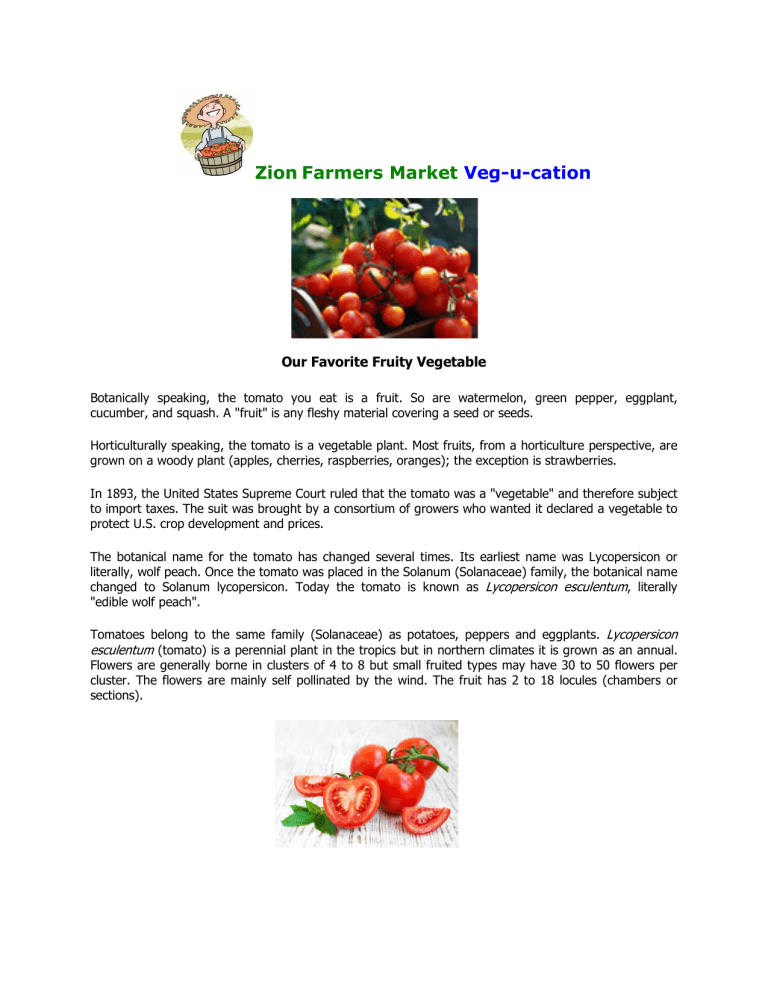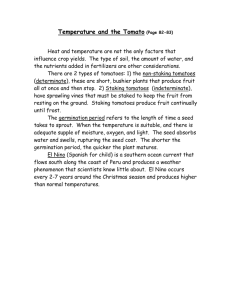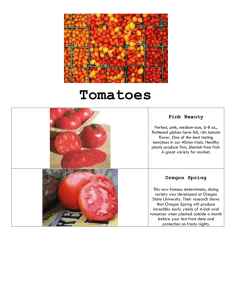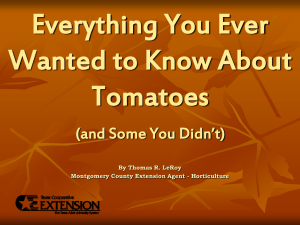Zion Farmers Market Veg-u-cation

Zion Farmers Market Veg-u-cation
Our Favorite Fruity Vegetable
Botanically speaking, the tomato you eat is a fruit. So are watermelon, green pepper, eggplant, cucumber, and squash. A "fruit" is any fleshy material covering a seed or seeds.
Horticulturally speaking, the tomato is a vegetable plant. Most fruits, from a horticulture perspective, are grown on a woody plant (apples, cherries, raspberries, oranges); the exception is strawberries.
In 1893, the United States Supreme Court ruled that the tomato was a "vegetable" and therefore subject to import taxes. The suit was brought by a consortium of growers who wanted it declared a vegetable to protect U.S. crop development and prices.
The botanical name for the tomato has changed several times. Its earliest name was Lycopersicon or literally, wolf peach. Once the tomato was placed in the Solanum (Solanaceae) family, the botanical name changed to Solanum lycopersicon. Today the tomato is known as Lycopersicon esculentum, literally
"edible wolf peach".
Tomatoes belong to the same family (Solanaceae) as potatoes, peppers and eggplants. Lycopersicon esculentum (tomato) is a perennial plant in the tropics but in northern climates it is grown as an annual.
Flowers are generally borne in clusters of 4 to 8 but small fruited types may have 30 to 50 flowers per cluster. The flowers are mainly self pollinated by the wind. The fruit has 2 to 18 locules (chambers or sections).
The tomato is a native of the Peru, Bolivia, and Ecuador area of the Andes Mountains. Its antiquity is uncertain in regard to cultivation but it was being cultivated prior to the arrival of the Europeans. It was not until the early 19th century that the tomato was considered suitable as a food crop in the northeastern United States.
Tomato Fun Facts
Slice them for sandwiches, toss them in salads, cook them into sauces or squeeze them for juice: tomatoes are delicious and good for us.
• Tomatoes are the fruit of the tomato plant. They originated in the South American Andes around the area of modern day Peru and was first used as a food by the Aztec's in Southern Mexico.
• Because the tomato has seeds and grows from a flowering plant botanically it is classed as a fruit not a vegetable.
• In 1887, U.S. tariff laws imposed a duty on vegetables, but not on fruits. This meant the status of tomatoes become a matter of legal importance. The U.S. Supreme Court ruled in the case of
Nix v. Hedden that tomatoes were to be considered vegetables, based on the popular definition that classifies vegetables by use, where they are usually served with dinner and not as a dessert.
However, the courts did not reclassify the tomato botanically, it is still a fruit.
• Tomatoes are the state vegetable of New Jersey. They are the official state fruit of Ohio and tomato juice is the official beverage of Ohio. However, Arkansas took both sides by stating the
South Arkansas Vine Ripe Pink Tomato as the state fruit and state vegetable, due to its culinary and botanical classifications.
• In cooler climates tomatoes are usually grown in glasshouses (greenhouses).
• China is the largest producer of tomatoes, accounting for one quarter of the worlds production in
2009. The United States and India and the second and third highest producers respectively.
• Pretty much all tomato varieties are red although other colors are possible including green, yellow, orange, pink, black, brown, white, and purple.
• There are more than 7500 tomato varieties grown around the world.
• Types of tomatoes include slicing (globe) tomatoes used in processing and for fresh eating.
Beefsteak tomatoes are large, often used for sandwiches. Oxheart tomatoes vary in size and are shaped like large strawberries. Plum tomatoes (including pear tomatoes), are usually oblong, and used in tomato sauce and paste. Cherry tomatoes are small round, often sweet and eaten whole in salads. Campari tomatoes are sweet and juicy of small to medium size.
• Tomatoes are rich in lycopene, an antioxidant that is good for the heart and effective against certain cancers. Cooked tomatoes are actually better for you than raw ones, as more beneficial chemicals are released. Tomatoes are also packed with vitamins A and C, calcium, potassium.
• The tomato is eaten in many different ways, raw like a fruit, as an ingredient in many dishes, sauces, salsas, salads, processed into ketchup or tomato soup. Tomato juice is made as a drink and used in cocktails like a Bloody Mary.
• Tomatoes are very popular in Mediterranean cuisines such as Italian. They are important ingredient in pizza and pasta sauces.
• The biggest tomato fight in the world happens each year in the small Spanish town of Buñol. The festival called La Tomatina, involves some 40,000 people throwing 150,000 tomatoes at each other.
• The Guinness World Record for most tomatoes harvested from a single plant over one year weighed 522.464 kg (1151.84 lbs) with 32,194 tomatoes harvested between May 2005 and April
2006. The tomato plant was at the Epcot Science project at Walt Disney World Company, Florida,
USA.
• As of 2013, the heaviest tomato according to Guinness World Record weighed 3.51 kg (7 lb 12 oz) and was grown by G. Graham in 1986, Oklahoma, USA.
• Eating cooked tomatoes may act as a kind of internal sunscreen, according to researchers at the
Universities of Manchester and Newcastle, England, by helping block UV rays. But eating tomatoes is only a supplement to using sunscreens, they caution, not a replacement.
You can save the seeds from hybrid tomatoes, but you won’t grow tomatoes exactly like the ones you started with. To get identical tomatoes, grow seeds from heirlooms.
According to the USDA, Americans eat 22-24 pounds of tomatoes per person, per year. About half of that comes in the form of ketchup and tomato sauce.
A whopping 93% of American gardeners grow tomatoes in their yards.
Forget the orange juice. Florida grows more tomatoes than any other state.
It’s thought that tomatoes originated in Peru, where their Aztec name meant, “plump thing with a navel.”
The world’s largest tomato tree was grown in the experimental greenhouse at Walt Disney World
Resort. It produced over 32,000 tomatoes in the first 16 months after it was planted, and holds the record for the most tomatoes in a single year, according to the Guinness Book of World
Records.
The scientific name for the tomato is Lycopersicon lycopersicum, which means, “wolf peach.”
Colonial American gardeners grew tomatoes for their looks, but were afraid to eat them, perhaps because the plants resembled deadly nightshade.








